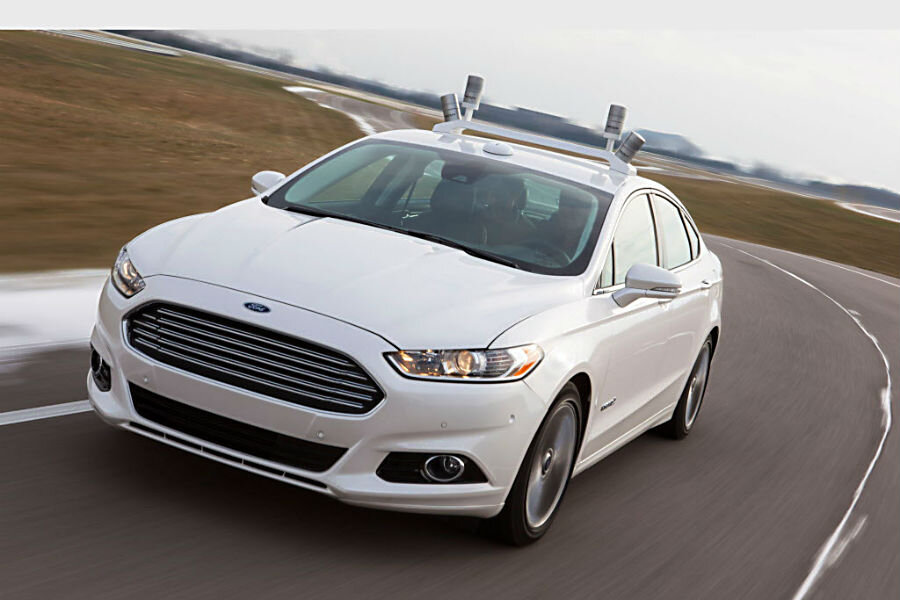Look ma, no hands – or feet! Is Ford winning the autonomous car race?
Loading...
Ford isn’t the only company that plans to release a self-driving car by 2021. But Ford's car won’t have a steering wheel or pedals, the automaker said Tuesday.
In a series of press appearances throughout the day, Ford's chief executive, Mark Fields, said the manufacturer plans to have fully autonomous cars serve as fleets for ride-hailing and package-delivery services in five years, and become available to consumers later that decade. To turn this dream into a reality, Ford has invested in four startups – Velodyne, SAIPS, Nirenberg Neuroscience, and Civil Maps – and plans to double the size of its operations in Silicon Valley.
Ford is not in a league of its own in developing a driverless car. Nearly three dozen companies are developing autonomous-car technology, according to CB Insights, and BMW and Volvo plan to release their own driverless cars by 2021 as well. General Motors is investing $500 million in Lyft as part of a driverless car effort. Toyota and Uber announced a similar partnership in May. Google and Apple are also involved in the race to produce driverless vehicles.
Where Ford apparently stands apart, however, is how it sees driverless cars revolutionizing how we travel: first through ride-hailing, and eventually trickling down to the masses. And its plan to get there appears to be the most robust the public has seen yet.
The vehicle will take a “full leap” into full autonomy, Raj Nair, Ford's executive vice president of product development, told the Detroit Free Press. "It’s not about level three automation – that would still require a driver,” he said.
Ford intends for the vehicle to be rated level four capable, meaning no driver would be required (hence, no steering wheel or pedals). Mr. Nair said it is safer to not have to rely on a driver to intervene in an emergency, since he isn’t sure a driver can go from inattentive to alert if necessary.
To achieve this goal, Ford announced it has invested in four technology startups. It confirmed it has teamed up with Velodyne, a firm that specializes in lidar (light detection and ranging) sensors that would allow a driverless car to “see” its surroundings. Velodyne said Tuesday it secured $150 million in funding from Ford and Baidu, a Chinese web-service provider. Ford also announced it has acquired SAIPS, a machine-learning firm, and signed an exclusive deal with Nirenberg Neuroscience, a machine vision and learning company.
Ford also plans to double its staff at its Silicon Valley office to 260 by the end of 2017. It will hire researchers and business-development staff to expand into new transportation services, according to The Wall Street Journal.
Ford said these moves will position it to introduce driverless cars first for ride-hailing, package-delivery services, and other commercial operations. It expects to offer these vehicles to consumers later in the decade. Offering driverless cars first for ride-sharing is a better way to reach the mass market and make the cars more affordable, according to Reuters.
“We’re dedicated to putting on the road an autonomous vehicle that can improve safety and solve social and environmental challenges for millions of people – not just those who can afford luxury vehicles,” said Fields, Ford’s chief executive, in a statement. “The next decade will be defined by automation of the automobile, and we see autonomous vehicles as having as significant an impact on society as Ford’s moving assembly line did 100 years ago.”
Yet, before driverless cars can hit the road, automakers have to prove they're safe. One concern is preventing accidents like the Tesla crash, the first fatality that involved a semi-autonomous vehicle. The driver was killed in May while the vehicle was in autopilot. The system and the driver didn’t notice a tractor-trailer turning in front of the sedan.
Although the crash highlighted the need for humans to remain attentive behind the wheel, Nair of Ford wants to avoid this situation with fully driverless cars. This approach, however, is radically different from the incremental approach of other autonomous-car developers. Current and future regulations could also slow how fast Ford can introduce these vehicles.
In May, the National Highway Traffic Safety Administration (NHTSA) released a study that highlighted problems with current and future regulations hindering the deployment of some fully autonomous self-driving cars. Current regulations would require self-driving cars be equipped with steering wheels, brake pedals, and other features for humans to take control. If those aren’t available, fully autonomous cars might not be street legal.







